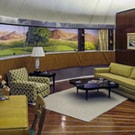
Dymaxion
House
Daily Activities at Dymaxion House
Conceived by visionary architect R. Buckminster Fuller as the home of the future, the Dymaxion House was designed to be the strongest, lightest, and most cost-effective housing ever built. Over the last decade, it has assumed an iconic presence in Henry Ford Museum of American Innovation. To some people it’s a giant Hershey’s Kiss. Others sense a kinship with the Airstream travel trailer. Painstakingly restored, it’s the only remaining prototype in the world.
Go on a guided tour through this one-of-a-kind home, designed by R. Buckminster Fuller. Please note that the historic design of the Dymaxion House does not accommodate wheelchairs or strollers. However, the home may be viewed from the deck at the top of the ramp, and a special exterior presentation is available upon request.
Highlights
Dymaxion House
Artifact
House
Date Made
1946
Summary
Buckminster Fuller was a multi-disciplinary designer. This house, his re-thinking of human shelter, was rooted in Fuller's understanding of industrial production -- particularly methods developed in the automobile industry and especially those advocated by Henry Ford for whom Fuller had immense admiration. More an engineering solution than a home, the structure was prototyped but never produced.
Place of Creation
Object ID
91.401.1
Credit
From the Collections of The Henry Ford. Gift of the William L. & Marjorie M. Graham Family, Wichita, Kansas
Get more details in Digital Collections at:
Dymaxion House
What is The Henry Ford?
The national attraction for discovering your ingenuity while exploring America’s spirit of innovation. There is always much to see and do at The Henry Ford.
Dymaxion House
Check out some of the amazing inventions you'll see first-hand when you take a journey through our Dymaxion House exhibit in Henry Ford Museum of American Innovation.

Dymaxion House
The circular house was designed to be easily transportable and shipped in a metal tube.

Resource-Efficient Dome Design
The round form encloses more space with less material than a square structure, using the "more with less" principle.



















